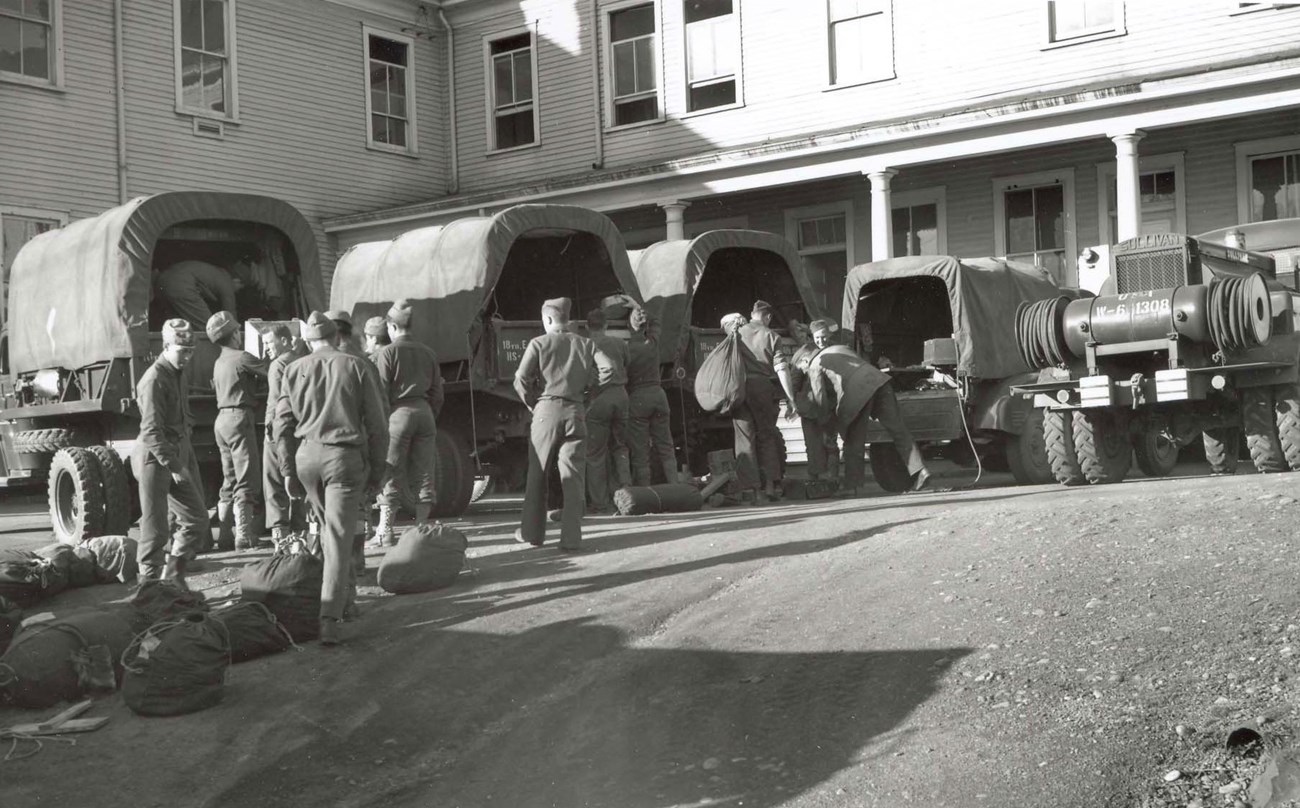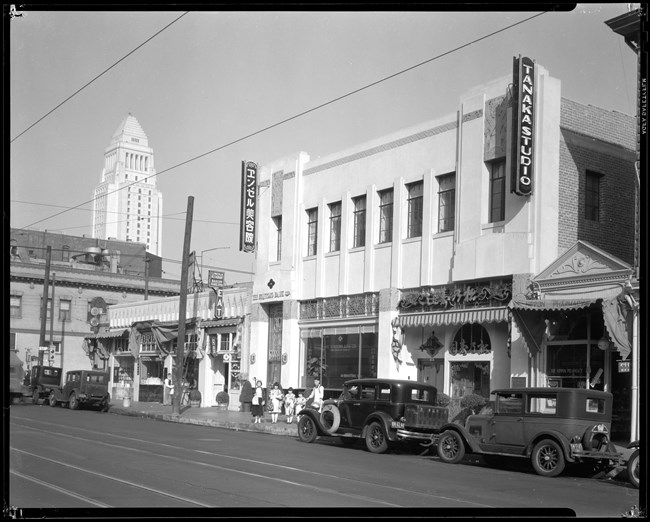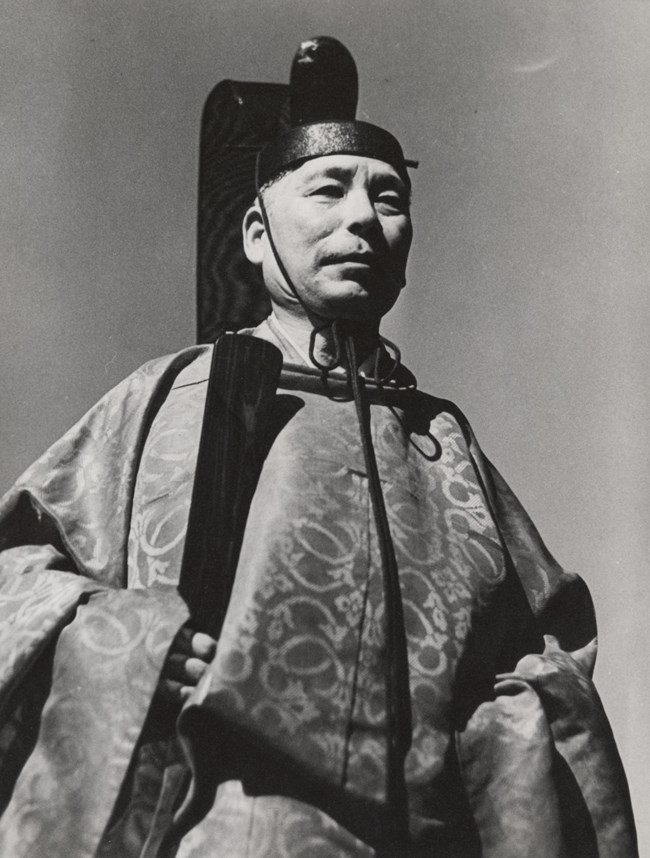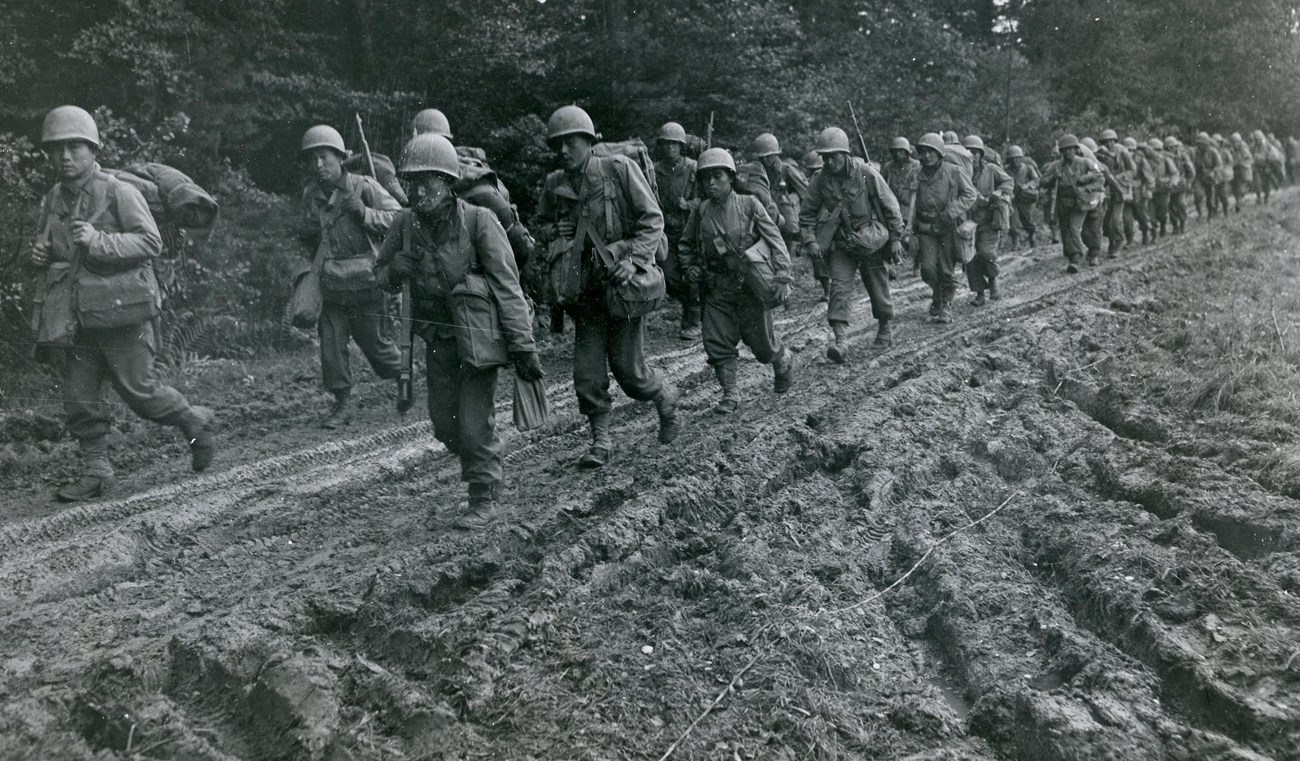Last updated: May 28, 2024
Article
Fighting on the Home Front: Two Japanese American Soldiers at Vancouver Barracks

Courtesy of Dale Denny
Overshadowed by the Pearl Harbor attacks and American entry into World War II, Christmas 1941 was a somber affair for the soldiers of Vancouver Barracks. Although a surviving dinner menu from the occasion reveals an elaborate meal that included roast turkey, fried oysters, and mince pie, the soldiers—members of the Army’s Eighteenth Engineers, Company E—might not have been in the mood for celebration. Congress’ declaration of war less than three weeks before had upended their lives, transforming them from a peacetime force to wartime soldiers who might be sent into combat at any time. Yet for two Japanese American members of Company E, Corporals Takashi Kiyomura and Yoshimi Yoshida, even the home front could be a place of hostility, separation, and uncertainty.
As the United States entered into war with Japan, they, their families, and the entire Japanese American community would face intensified racism and suspicion from their government and fellow Americans, ultimately demonstrated in the forced removal and incarceration of the over 120,000 Japanese Americans who called the West Coast home, including Kiyomura and Yoshida’s own families.
Although the historical record on these two soldiers is limited, the information we do have allows us to understand some of the past experiences and events they might have been considering during their Christmas dinner, and the future they would face. Their story connects this place to the history of Japanese Americans in World War II and broadens our understanding of what it meant to be a soldier at Vancouver Barracks.

Japanese American National Museum (In Memory of Chikashi & Asa Tanaka and Yasuo “Clifford” & Yuri Tanaka, 2077.61.124_2)
Newcomers to the Northwest: From Little Tokyo to Vancouver Barracks
Even before the events of Pearl Harbor plunged the nation into war, 1941 had been a year of significant transition and change for Kiyomura and Yoshida. Both born in 1917, these two corporals of Company E had grown up in the Los Angeles area, home to the largest Japanese American community in North America. Over 35,000 Japanese Americans, mostly first-generation Issei and second-generation Nisei like Kiyomura and Yoshida, made their home there, centered around the downtown Los Angeles neighborhood known as “Little Tokyo.”Kiyomura, raised in the nearby city of Gardena, and Yoshida, whose family lived in Orange County, would have patronized the many stores and restaurants of Little Tokyo, worshipped with other Japanese Americans in temples and churches, and participated in festivals and other cultural celebrations. On February 26, 1941, however, Kiyomura chose to leave his life in California and join the United States Army. According to enlistment records, Yoshida enlisted the next day. Given these close dates, it is possible that they knew each other during civilian life, and perhaps even made this decision together.
For young Asian Americans, Army life could bring social and economic opportunities. During World War I, thousands of Japanese immigrants volunteered for military service and eventually gained citizenship as a result. Kiyomura and Yoshida might have also enlisted out of a desire for adventure, travel, and new experiences, something they might have felt was lacking in their previous occupations as a farm foreman and a sales clerk.
The two 24-year-old Californians were assigned to Company E of the Army’s 18th Engineers. The unit had been stationed at Vancouver Barracks since 1940 to improve infrastructure at the post, including the construction of the new Barnes General Hospital that broke ground on January 9, 1940. Upon arrival, Kiyomura and Yoshida found themselves adjusting to an entirely new way of life, far from both family and community. We can imagine that these transitions would have brought novelty and opportunity, as well as isolation. Beyond the rules and regulations of a soldier’s life, Kiyomura and Yoshida were (from Army records) the only two Japanese Americans in their company. In addition, the 1940 census listed only 110 Japanese Americans living in Clark County. One of these residents, a woman named Pearl Yoshikawa, recounted decades later that these few families preferred to keep to themselves rather than form a larger Nikkei community in Vancouver. For the two newcomers, used to the large yet tight knit world of Japanese American Southern California, this lack of ethnic community could have been quite isolating.

Japanese American National Museum (Gift of the Sutow Family, 88.7.4)
After Pearl Harbor: Condemned Without Trial
If the two soldiers had felt isolated before, the wave of anti-Japanese activity immediately following Pearl Harbor dispelled any hope that Japanese Americans like them would be safe from racist profiling. By the time the two men sat down to Christmas dinner, the FBI had already arrested dozens of Issei in nearby Portland, Oregon, alleging that they were security threats. These individuals, often Japanese language schoolteachers, martial arts instructors, members of civic organizations, or other community leaders, were taken from their homes and families and incarcerated in Portland before their relocation to Department of Justice-run detainment camps throughout the country. Although none of these individuals were found guilty of espionage or subversion, some would not see their families again until 1946.These sudden arrests shocked Japanese American communities across the country, sending the message that, only because of their race, they were considered a threat to national security. In contrast to communities like Little Tokyo, Portland’s Japanese American population was small (less than 2,000 in 1940) and relatively isolated, leaving them without support from their neighbors. Portland’s local government also showed itself to be uniquely hostile. For instance, in January 1942, before federal restrictions on Japanese Americans, Portland’s City Council prohibited all Issei from holding business licenses, making them the only city in the nation to do so.
Family separation, arrests, curfews, vandalism of Japanese businesses, and even violence placed enormous stress on Japanese Americans in the waning days of 1941. Arrests like those of Portland Issei affected Southern California as well. Kiyomura and Yoshida might have known some of the thousands arrested there, perhaps worrying that their own parents might be next. Even as US citizens in the armed forces, their future was uncertain. Many of the approximately 5,000 Japanese American soldiers in service during the Pearl Harbor attacks found themselves discharged or reassigned to new units and menial labor. After the United States entered WW2, thousands of Nisei joined their fellow Americans in volunteering for military service, but were rejected, classified as “enemy aliens unfit for service.”
Like all Japanese Americans, Kiyomura and Yoshida had to accept the reality that many of their neighbors and even their government would treat them as threats and strangers in their own land. As they ate Christmas dinner with their fellow soldiers at Vancouver Barracks, they may have wondered how long their camaraderie would last, or if even they would be seen as an enemy. Fortunately, at least a few of their comrades were willing to extend some tolerance. Writing home in 1941, Private Henry Tyvand of Company E mentioned that his unit included “two Japanese,” describing them as “fine chaps” who were “as patriotic as anyone.” Unfortunately, such assessments of Japanese American loyalty were shared by few; many Americans hardly questioned the need for incarceration. A 1942 Gallup poll found that the American public overwhelmingly supported forced removal of both citizens (59%) and non-citizens (93%) alike.
Although we do not know what happened to Kiyomura and Yoshida after this Christmas dinner, a number of historical clues can help us envision their lives during and after World War II. Records indicate that Kiyomura advanced to the rank of staff sergeant (two ranks above a corporal), making it likely that he remained in military service for several years after.
No such records have been located for Yoshida, but since he does not appear in the roster of the Japanese Americans incarcerated beginning in 1942, it is likely both men stayed in the Army for some or all of the war. If they did in fact remain with the 18th Engineers, they would have once again moved north, this time to British Columbia, as the unit constructed over 300 miles of the Alcan Highway to aid transport during wartime. When complete, the highway stretched from Alberta, Canada to Fairbanks, Alaska.

Courtesy of the National Archives and Records Administration
Civilians Behind Barbed Wire: Wartime Incarceration
However, whether in military or civilian life, Kiyomura and Yoshida faced the forced removal and incarceration of their fellow Japanese Americans from the West Coast. Authorized by President Franklin Delano Roosevelt’s Executive Order 9066 in February 1942, this measure forced American citizens and Japanese immigrants alike from their homes and communities in the name of military necessity. Beginning in March 1942, 120,000 Japanese Americans had only a few weeks to pack what they could carry before boarding trains and buses to local temporary detention facilities. From there, they would be transported to one of ten incarceration camps throughout the Inner West.As with other Japanese American neighborhoods along the West Coast, Little Tokyo and the surrounding community became a ghost town almost overnight. The tens of thousands of Japanese Americans who called it home were forced to sell their homes and livelihoods at huge losses or trust in the goodwill of neighbors and friends to care for it in their absence. Among these displaced people were Kiyomura’s older brother Koichi, his wife Anna, and their two small children Masao and Towru.
Koichi, 27, a retail manager, and Anna, 23, a sales clerk, uprooted their family and joined over 18,000 Japanese Americans at the Santa Anita Assembly Center, located on the grounds of a horse racing track northeast of Los Angeles. During its seven-month operation, incarcerated people lived in hastily converted horse stalls or barracks where sewage flowed past in open trenches. From there, Koichi and Anna, along with 4,400 others, were transported over 1,700 miles to Rohwer War Relocation Center, an incarceration camp in southeastern Arkansas, arriving at its barbed wire gates and guard towers on September 30, 1942.

Courtesy of the National Archives and Records Administration
Although camp rosters do not indicate that Takashi Kiyomura was ever incarcerated, the news of his friends and family’s experiences must have been distressing, yet another sign that their own country, the country he had chosen to serve, had turned against them for no reason other than their race.
The two brothers may have remained separated even after Koichi’s incarceration. By 1943, Japanese Americans were permitted to leave incarceration camps for new homes, so long as they did not return to the West Coast. Koichi and Anna chose this option, leaving Rohwer for Chicago in June 1943. Like the thousands of others who resettled in the Midwest and East Coast, they found themselves isolated in a new place, slowly working to rebuild home and community.

U.S. Army
Defining Patriotism: Japanese Americans and Military Service
If Kiyomura and Yoshida continued their military service past 1941, they would be joined by the thousands of Japanese American recruits from both Hawai’i and the US mainland, beginning in 1943. As previously mentioned, after the United States declared war on Japan, the War Department had classified all Japanese Americans, including those born in the United States, as ineligible for service by 1942. However, by early 1943, due to lobbying from Japanese American civic organizations, a need for soldiers, and a lack of evidence for espionage or sabotage from Japanese Americans, the Army began to accept enlistees.
Courtesy of the National Archives and Records Administration
Many enlistees arrived at basic training from incarceration camps, where their families and friends remained behind barbed wire. At Rohwer, 581 Japanese Americans joined the Army. As most people incarcerated in Rohwer came from the Los Angeles area, Kiyomura and Yoshida would have likely known many of the new enlistees since childhood and mourned the 31 soldiers from Rohwer who died in action. In honor of the fallen, their incarcerated family and friends designed and built a monument that still stands in the former camp’s cemetery. Their valor and sacrifice, and that of all Japanese American soldiers, starkly reveals the twisted illogic of wartime incarceration: a nation that would take their service, even their lives, yet continue to deny the rights of their community and incarcerate their loved ones because of their race.
Conclusion: Uncovering Hidden Wartime Stories
The stories of Kiyomura and Yoshida allow us to consider what it might have been like to have one’s own nation turn against you and your family while you were actively serving it. While it does not appear that they were incarcerated, these two soldiers of Company E still experienced wartime as Japanese Americans, branded as enemies by their own government and witnessing their family and friends forced from their homes. Vancouver Barracks and military service were at once a shelter from incarceration and a place of isolation from community, from which Kiyomura and Yoshida could not leave without facing incarceration themselves.Although we might not have many records on these two soldiers, sources as mundane as a dinner menu and an enlistment form show us a much wider story. Through the process of historical imagination, we can explore how Kiyomura and Yoshida might have dealt with questions of loyalty, injustice, and patriotism and challenge ourselves to consider how we understand and engage with these issues today.
References
“Find a Grave: Takashi Kiyomura.” Veterans Legacy Memorial. https://www.vlm.cem.va.gov/TAKASHIKIYOMURA/26A4131.Japanese American Veterans Association. “Over 800 Immigrant Japanese and Nisei Served in US Army during World War I. Road to Gain Citizenship was Long and Arduous.” Discover Nikkei, June 3, 2019. https://discovernikkei.org/en/journal/2019/6/3/wwi-veterans/.
Linke, Konrad. "Santa Anita (detention facility).” Densho Encyclopedia. https://encyclopedia.densho.org/Santa_Anita_(detention_facility)/.
Muller, Eric. “Draft Resistance.” Densho Encyclopedia. https://encyclopedia.densho.org/Draft%20resistance.
Niiya, Brian. “No-No Boys.” Densho Encyclopedia. https://encyclopedia.densho.org/No-no_boys/#cite_ref-ftnt_ref1_1-0.
“Rohwer.” Densho Encyclopedia. https://encyclopedia.densho.org/Rohwer.
Sinclair, Donna. ‘In the Heart of the City’: A Historic Resource Study of Vancouver Barracks. Vancouver: Fort Vancouver National Historic Site, 2022.
United States Army. “Enlistment Record: Kiyomura, Takashi.” National Archives and Records Administration.
United States Army. “Enlistment Record: Yoshida, Yoshimi.” National Archives and Records Administration.
Vogt, Tom. “Off beat—Vancouver Barracks’ 1941 Menu Has Many Stories to Tell.” The Columbian, December 27, 2015. https://www.columbian.com/news/2015/dec/27/vancouver-barracks-1941-menu-has-many-stories-to-tell/.
War Relocation Authority. “Kittaka, Shinnosu – Kobayashi, Masahiro.” In Final Accountability Roster of the Rohwer Relocation Center, November 1945. Washington, D. C.: National Archives and Records Administration, 1956. https://ddr.densho.org/ddr-densho-305-9-master-92933f5127/.
War Relocation Authority. “Kiyomura, Anna.” National Archives and Records Administration.
War Relocation Authority. “Kiyomura, Koichi.” National Archives and Records Administration.
Yoshikawa, Pearl. “Pearl Yoshikawa Interview.” Interviewed by Carolyn Nayematsu, October 12, 2009. Densho. https://ddr.densho.org/media/ddr-densho-1014/ddr-densho-1014-12-transcript-28627eff42.htm.
Yuzuhira, Jill. “Taken: Oregon Japanese Arrested by the FBI During World War II—Part 2.” Discover Nikkei, February 17, 2010. https://discovernikkei.org/en/journal/2010/2/17/oregon-japanese-arrested/.
